Deck 7: Basic BJT Amplifiers
Question
Question
Question
Question
Question
Question
Question
Question
Question
Question
Question
Question
Question
Question
Question
Question
Question
Question
Question
Question
Question
Question
Question
Question
Question
Question
Question
Question
Question
Question
Question
Question
Question
Question
Question
Question
Question
Question
Question
Question
Question
Question
Question
Question
Question
Question
Question
Question
Question
Question
Question
Question

Unlock Deck
Sign up to unlock the cards in this deck!
Unlock Deck
Unlock Deck
1/52
Play
Full screen (f)
Deck 7: Basic BJT Amplifiers
1
It is standard practice to use capital letters and subscripts for dc quantities.
True
2
Distortion is desirable in high-fidelity amplifiers because it changes the sound of voice and music.
False
3
The ac current gain equals the ac collector current divided by the ac base current.
True
4
The unbypassed emitter resistance is called a feedback resistor because it has an ac voltage across it that opposes changes in voltage gain.

Unlock Deck
Unlock for access to all 52 flashcards in this deck.
Unlock Deck
k this deck
5
When coupling an ac signal from stage to stage,the capacitive reactance should be at least
A) 10 times smaller than the resistance at the lowest frequency of operation.
B) 100 times smaller than the resistance at the lowest frequency of operation.
C) 10 times larger than the resistance at the lowest frequency of operation.
D) 10 times smaller than the resistance at the highest frequency of operation.
A) 10 times smaller than the resistance at the lowest frequency of operation.
B) 100 times smaller than the resistance at the lowest frequency of operation.
C) 10 times larger than the resistance at the lowest frequency of operation.
D) 10 times smaller than the resistance at the highest frequency of operation.

Unlock Deck
Unlock for access to all 52 flashcards in this deck.
Unlock Deck
k this deck
6
The voltage gain of an amplifier is defined as the ac output voltage divided by the ac input voltage.

Unlock Deck
Unlock for access to all 52 flashcards in this deck.
Unlock Deck
k this deck
7
A bypass capacitor is similar to a coupling capacitor because it appears open to dc and shorted to ac.

Unlock Deck
Unlock for access to all 52 flashcards in this deck.
Unlock Deck
k this deck
8
Coupling capacitors can be approximated as dc shorts.

Unlock Deck
Unlock for access to all 52 flashcards in this deck.
Unlock Deck
k this deck
9
The common-emitter amplifier can be recognized by noting that the emitter is at dc ground.

Unlock Deck
Unlock for access to all 52 flashcards in this deck.
Unlock Deck
k this deck
10
If there is any ac voltage at an amplifier's bypass emitter,it means that the
A) transistor is shorted.
B) transistor is open.
C) coupling capacitor is open.
D) bypass capacitor is open.
A) transistor is shorted.
B) transistor is open.
C) coupling capacitor is open.
D) bypass capacitor is open.

Unlock Deck
Unlock for access to all 52 flashcards in this deck.
Unlock Deck
k this deck
11
A coupling capacitor couples an ac signal into an amplifier without disturbing its operating point.

Unlock Deck
Unlock for access to all 52 flashcards in this deck.
Unlock Deck
k this deck
12
Voltage gain is ac output voltage divided by the ac input voltage.

Unlock Deck
Unlock for access to all 52 flashcards in this deck.
Unlock Deck
k this deck
13
The impedance of a capacitor is inversely proportional to the frequency and the capacitor effectively blocks dc voltage.

Unlock Deck
Unlock for access to all 52 flashcards in this deck.
Unlock Deck
k this deck
14
The voltage gain equals the ac collector resistance divided by the ac resistance of the collector diode.

Unlock Deck
Unlock for access to all 52 flashcards in this deck.
Unlock Deck
k this deck
15
The ac equivalent circuit model called the Ebers-Moll looks like a P on its side and is sometimes called a P model.

Unlock Deck
Unlock for access to all 52 flashcards in this deck.
Unlock Deck
k this deck
16
One way to reduce distortion in a transistor amplifier is to keep the base ac input voltage small.

Unlock Deck
Unlock for access to all 52 flashcards in this deck.
Unlock Deck
k this deck
17
What is the mathematical approach that models the transistor on what is happening at its terminals without regard for the physical processes taking place inside the transistor?
A) small-signal characteristics
B) Thevenin's Theorem
C) Kirchoff's Laws
D) h parameters
A) small-signal characteristics
B) Thevenin's Theorem
C) Kirchoff's Laws
D) h parameters

Unlock Deck
Unlock for access to all 52 flashcards in this deck.
Unlock Deck
k this deck
18
One way to stabilize voltage gain is to leave some of the emitter resistance unbypassed.

Unlock Deck
Unlock for access to all 52 flashcards in this deck.
Unlock Deck
k this deck
19
The ac resistance of the emitter diode equals the ac base-emitter voltage divided by the ac emitter current.

Unlock Deck
Unlock for access to all 52 flashcards in this deck.
Unlock Deck
k this deck
20
Discrete means all components like resistors,capacitors,and transistors are created and connected on a chip,a piece of semiconductor material.

Unlock Deck
Unlock for access to all 52 flashcards in this deck.
Unlock Deck
k this deck
21
The stretching and compressing of alternate half cycles at the output of a transistor amplifier is called ________.
A) oscillation
B) amplification
C) distortion
D) extortion
A) oscillation
B) amplification
C) distortion
D) extortion

Unlock Deck
Unlock for access to all 52 flashcards in this deck.
Unlock Deck
k this deck
22
The reactance of a coupling capacitor at dc voltage is ________.
A) zero
B) infinite
C) 100 kW
D) 1.414 W
A) zero
B) infinite
C) 100 kW
D) 1.414 W

Unlock Deck
Unlock for access to all 52 flashcards in this deck.
Unlock Deck
k this deck
23
Distortion is undesirable in high-fidelity amplifiers because
A) it changes the sound of voice and music.
B) it amplifies the sound of voice and music.
C) it trips a circuit breaker.
D) it cannot be heard in either speaker.
A) it changes the sound of voice and music.
B) it amplifies the sound of voice and music.
C) it trips a circuit breaker.
D) it cannot be heard in either speaker.

Unlock Deck
Unlock for access to all 52 flashcards in this deck.
Unlock Deck
k this deck
24
The simplest way to analyze an amplifier is to split the analysis into what two parts?
A) schematics and values
B) amplifiers and oscillators
C) dc and ac
D) semiconductors and conductors
A) schematics and values
B) amplifiers and oscillators
C) dc and ac
D) semiconductors and conductors

Unlock Deck
Unlock for access to all 52 flashcards in this deck.
Unlock Deck
k this deck
25
In order to calculate the collector current for the circuit shown in Figure 8-2 (a),you must 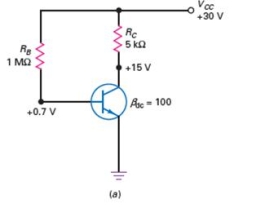
A) divide 15 V by 100.
B) multiply the base current by 100.
C) multiply 0.7 V by 100.
D) divide 30 V by 5 kW.

A) divide 15 V by 100.
B) multiply the base current by 100.
C) multiply 0.7 V by 100.
D) divide 30 V by 5 kW.

Unlock Deck
Unlock for access to all 52 flashcards in this deck.
Unlock Deck
k this deck
26
In transistor amplifier notation,lowercase letters and subscripts are used for
A) dc quantities.
B) ac quantities.
C) schematic symbols.
D) labeling filters.
A) dc quantities.
B) ac quantities.
C) schematic symbols.
D) labeling filters.

Unlock Deck
Unlock for access to all 52 flashcards in this deck.
Unlock Deck
k this deck
27
What is the term that describes components such as resistors,capacitors,and transistors that are separately inserted and connected to get a final circuit?
A) discrete
B) integrated
C) chip
D) printed circuit
A) discrete
B) integrated
C) chip
D) printed circuit

Unlock Deck
Unlock for access to all 52 flashcards in this deck.
Unlock Deck
k this deck
28
The ac collector current divided by the ac base current is referred to as
A) dc current gain.
B) ac current gain.
C) alpha.
D) delta.
A) dc current gain.
B) ac current gain.
C) alpha.
D) delta.

Unlock Deck
Unlock for access to all 52 flashcards in this deck.
Unlock Deck
k this deck
29
What is a method used to analyze an amplifier in which each source is calculated separately while the other source is reduced to zero?
A) Kirchoff's Laws
B) Fourier's analysis
C) Lenz's Law
D) superposition
A) Kirchoff's Laws
B) Fourier's analysis
C) Lenz's Law
D) superposition

Unlock Deck
Unlock for access to all 52 flashcards in this deck.
Unlock Deck
k this deck
30
When a single or double stage amplifier is not working,troubleshooting can begin by measuring dc voltages.

Unlock Deck
Unlock for access to all 52 flashcards in this deck.
Unlock Deck
k this deck
31
In order for a bypass capacitor to work properly,its reactance must be
A) much smaller than the resistance.
B) much larger than the resistance.
C) equal to the resistance.
D) infinite.
A) much smaller than the resistance.
B) much larger than the resistance.
C) equal to the resistance.
D) infinite.

Unlock Deck
Unlock for access to all 52 flashcards in this deck.
Unlock Deck
k this deck
32
In a well-designed coupling circuit,the coupling capacitor approximates
A) an ac open.
B) a dc short.
C) a dc open.
D) an ac short.
A) an ac open.
B) a dc short.
C) a dc open.
D) an ac short.

Unlock Deck
Unlock for access to all 52 flashcards in this deck.
Unlock Deck
k this deck
33
A swamped amplifier decreases input impedance and increases distortion.

Unlock Deck
Unlock for access to all 52 flashcards in this deck.
Unlock Deck
k this deck
34
The ac output voltage of an amplifier divided by the ac input voltage is referred to as the amplifier's
A) power output.
B) power gain.
C) voltage gain.
D) beta.
A) power output.
B) power gain.
C) voltage gain.
D) beta.

Unlock Deck
Unlock for access to all 52 flashcards in this deck.
Unlock Deck
k this deck
35
The ac base-emitter voltage divided by the ac emitter current equals
A) ac resistance.
B) dc resistance.
C) reactance.
D) impedance.
A) ac resistance.
B) dc resistance.
C) reactance.
D) impedance.

Unlock Deck
Unlock for access to all 52 flashcards in this deck.
Unlock Deck
k this deck
36
When all components are simultaneously created and connected on a piece of semiconductor material,it is referred to as what kind of circuit?
A) discrete
B) integrated
C) chat
D) protection
A) discrete
B) integrated
C) chat
D) protection

Unlock Deck
Unlock for access to all 52 flashcards in this deck.
Unlock Deck
k this deck
37
What is one way to minimize distortion?
A) use batteries only
B) keep amplifier dc supply voltages low
C) use ICs
D) keep ac base voltages small
A) use batteries only
B) keep amplifier dc supply voltages low
C) use ICs
D) keep ac base voltages small

Unlock Deck
Unlock for access to all 52 flashcards in this deck.
Unlock Deck
k this deck
38
An equivalent transistor circuit model used to analyze ac signal processing that looks like a T on its side is the
A) Fourier model.
B) p model.
C) Thevenin model.
D) Ebers-Moll model.
A) Fourier model.
B) p model.
C) Thevenin model.
D) Ebers-Moll model.

Unlock Deck
Unlock for access to all 52 flashcards in this deck.
Unlock Deck
k this deck
39
What is the most popular circuit model that is used to analyze how a transistor behaves when an ac signal is present?
A) Fourier model.
B) p model.
C) Thevenin model.
D) Ebers-Moll model.
A) Fourier model.
B) p model.
C) Thevenin model.
D) Ebers-Moll model.

Unlock Deck
Unlock for access to all 52 flashcards in this deck.
Unlock Deck
k this deck
40
The base current for the circuit shown in Figure 8-2 (a)can be determined by 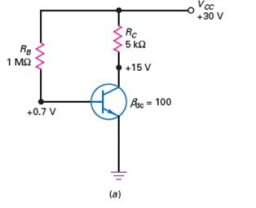
A) dividing 100 by 5 kW.
B) dividing 30 V by 5 kW.
C) dividing 30 V by 1 MW.
D) dividing 15 V by 100.

A) dividing 100 by 5 kW.
B) dividing 30 V by 5 kW.
C) dividing 30 V by 1 MW.
D) dividing 15 V by 100.

Unlock Deck
Unlock for access to all 52 flashcards in this deck.
Unlock Deck
k this deck
41
In the circuit shown in Figure 8-4,what effect do the capacitors have on the dc biasing? 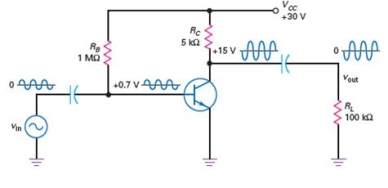
A) add 0.7 V
B) add 15 V
C) puts transistor in cutoff
D) no effect

A) add 0.7 V
B) add 15 V
C) puts transistor in cutoff
D) no effect

Unlock Deck
Unlock for access to all 52 flashcards in this deck.
Unlock Deck
k this deck
42
In the circuit shown in Figure 8-30,if the collector voltage is 0 V and the base voltage is 0 V,what is the trouble? 
A) 1 mV generator open
B) C1 open
C) C3 shorted
D) +10 V supply is faulty

A) 1 mV generator open
B) C1 open
C) C3 shorted
D) +10 V supply is faulty

Unlock Deck
Unlock for access to all 52 flashcards in this deck.
Unlock Deck
k this deck
43
If excessive hum is heard coming out of a loudspeaker,one of the prime suspects is a shorted diode in the power supply.

Unlock Deck
Unlock for access to all 52 flashcards in this deck.
Unlock Deck
k this deck
44
What makes the p model,an equivalent transistor circuit model,easier to use than other models?
A) it shows input impedance
B) it uses Ohm's Law
C) it uses calculus
D) it shows output impedance
A) it shows input impedance
B) it uses Ohm's Law
C) it uses calculus
D) it shows output impedance

Unlock Deck
Unlock for access to all 52 flashcards in this deck.
Unlock Deck
k this deck
45
In the circuit shown in Figure 8-30,if the ac collector voltage is 2 mV and the dc collector voltage is 6 V,what is the trouble? 
A) C1 is shorted
B) C1 is open
C) +10 V supply is faulty
D) 2.2 kΩ resistor is open

A) C1 is shorted
B) C1 is open
C) +10 V supply is faulty
D) 2.2 kΩ resistor is open

Unlock Deck
Unlock for access to all 52 flashcards in this deck.
Unlock Deck
k this deck
46
The amplifier shown in Figure 8-4 is 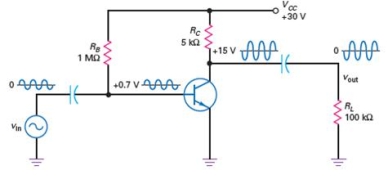
A) an emitter-biased amplifier.
B) a base-biased amplifier.
C) a common collector.
D) an emitter follower.

A) an emitter-biased amplifier.
B) a base-biased amplifier.
C) a common collector.
D) an emitter follower.

Unlock Deck
Unlock for access to all 52 flashcards in this deck.
Unlock Deck
k this deck
47
Amplified ripple out of a loudspeaker is detected as
A) sine waves.
B) high pitch noise.
C) high frequency signals.
D) low frequency hum.
A) sine waves.
B) high pitch noise.
C) high frequency signals.
D) low frequency hum.

Unlock Deck
Unlock for access to all 52 flashcards in this deck.
Unlock Deck
k this deck
48
In the circuit shown in Figure 8-8,if an ac voltage was measured between the emitter and ground 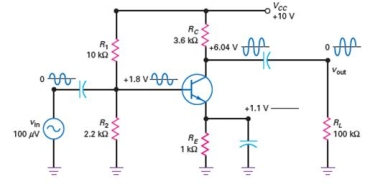
A) this is normal.
B) this means the amplifier is in cutoff.
C) this means that the bypass capacitor is open.
D) this means the transistor is open.

A) this is normal.
B) this means the amplifier is in cutoff.
C) this means that the bypass capacitor is open.
D) this means the transistor is open.

Unlock Deck
Unlock for access to all 52 flashcards in this deck.
Unlock Deck
k this deck
49
Which statement is true with regard to the circuit shown in Figure 8-4? 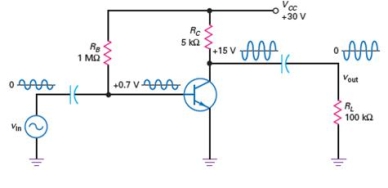
A) the ac signal out of the transistor is amplified and inverted
B) the ac signal out of the transistor is amplified and in-phase with the input
C) the ac signal out of the transistor is not amplified
D) the ac signal out of the transistor is attenuated

A) the ac signal out of the transistor is amplified and inverted
B) the ac signal out of the transistor is amplified and in-phase with the input
C) the ac signal out of the transistor is not amplified
D) the ac signal out of the transistor is attenuated

Unlock Deck
Unlock for access to all 52 flashcards in this deck.
Unlock Deck
k this deck
50
The circuit shown in Figure 8-30 has an ac emitter voltage of 0.75 mV and an ac collector voltage of 5 mV.What is the trouble? 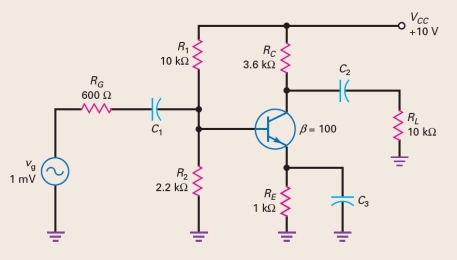
A) C3 open
B) C3 shorted
C) C2 open
D) C2 shorted

A) C3 open
B) C3 shorted
C) C2 open
D) C2 shorted

Unlock Deck
Unlock for access to all 52 flashcards in this deck.
Unlock Deck
k this deck
51
A bypass capacitor appears
A) shorted to dc.
B) open to ac.
C) open to dc.
D) like a semiconductor.
A) shorted to dc.
B) open to ac.
C) open to dc.
D) like a semiconductor.

Unlock Deck
Unlock for access to all 52 flashcards in this deck.
Unlock Deck
k this deck
52
Using the values listed on the circuit shown in Figure 8-8,what is the approximate value for the collector current? 
A) 20 mA
B) 1 mA
C) 1 mA
D) 10 m

A) 20 mA
B) 1 mA
C) 1 mA
D) 10 m

Unlock Deck
Unlock for access to all 52 flashcards in this deck.
Unlock Deck
k this deck



